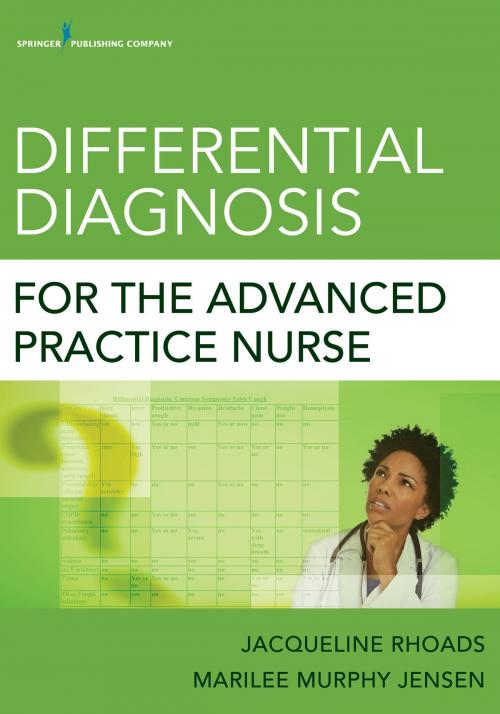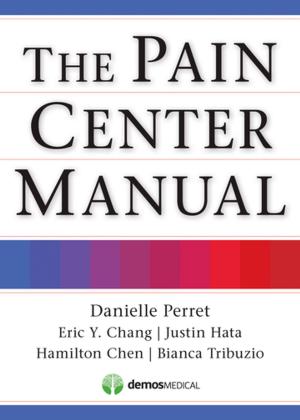Differential Diagnosis for the Advanced Practice Nurse
Nonfiction, Health & Well Being, Medical, Nursing, Assessment & Diagnosis, Specialties, Family & General Practice| Author: | ISBN: | 9780826110282 | |
| Publisher: | Springer Publishing Company | Publication: | July 17, 2014 |
| Imprint: | Springer Publishing Company | Language: | English |
| Author: | |
| ISBN: | 9780826110282 |
| Publisher: | Springer Publishing Company |
| Publication: | July 17, 2014 |
| Imprint: | Springer Publishing Company |
| Language: | English |
"Developing a comprehensive differential diagnosis for a specific complaint is a daunting task even for experienced advanced practice nurses. This user-friendly clinical guide provides a strategy or standard format for working through this complex task. It is a wonderful tool for both student and new advanced practice nurses... 5 stars." -- Kathleen M. Woodruff, DNP, Doody's Book Reviews
Establishing a differential diagnosis can be challenging even for expert advanced practice nurses (APRNs), let alone students. This easy-access clinical guide to commonly seen symptoms, written for APRN students and new practitioners, describes step by step how to obtain a reliable patient history and choose the appropriate directed physical exam for the presenting problem, followed by how to use this patient history and physical exam findings to form a differential diagnosis. Unfolding case scenarios provided for each symptom further demonstrate a sound process for formulating a differential diagnosis that the APRN can use throughout clinical practice.
The book features 38 of the most commonly presented symptoms, each of which includes exam findings and differential diagnosis. It describes diagnostic tests with a guide to when they should be ordered (or delayed) based on clinical findings, and common management plans for diagnostic testing. It discusses the correct approach to diagnostic reasoning including determining the focused assessment, choosing the appropriate assessment tests or lab tests, and critically thinking through the assessment and diagnostic data to arrive at an appropriate diagnosis. A unique feature of the guide is its provision of a Case Study History (presenting directed questions and patient responses), Physical Exam Findings, a Differential Diagnosis Table (clearly comparing potential diagnostic choices based on symptoms), a Diagnostic Examination Table (including estimated costs and codes), and a Case Study Summary, to further clarify strategies for arriving at the correct diagnosis.
Key Features:
- Helps students and novice nurses obtain directed problem-focused history and examination for common patient symptoms
- Demonstrates a step-by-step approach to building clinical decision-making skills
- Offers quick access to common differential diagnoses, requisite diagnostic tests, and clinical decision making
- Uses unfolding case scenarios for each symptom to illustrate the clinical decision-making, diagnostic process
- Includes unique tables that help to clarify strategies for diagnostic decision making
"Developing a comprehensive differential diagnosis for a specific complaint is a daunting task even for experienced advanced practice nurses. This user-friendly clinical guide provides a strategy or standard format for working through this complex task. It is a wonderful tool for both student and new advanced practice nurses... 5 stars." -- Kathleen M. Woodruff, DNP, Doody's Book Reviews
Establishing a differential diagnosis can be challenging even for expert advanced practice nurses (APRNs), let alone students. This easy-access clinical guide to commonly seen symptoms, written for APRN students and new practitioners, describes step by step how to obtain a reliable patient history and choose the appropriate directed physical exam for the presenting problem, followed by how to use this patient history and physical exam findings to form a differential diagnosis. Unfolding case scenarios provided for each symptom further demonstrate a sound process for formulating a differential diagnosis that the APRN can use throughout clinical practice.
The book features 38 of the most commonly presented symptoms, each of which includes exam findings and differential diagnosis. It describes diagnostic tests with a guide to when they should be ordered (or delayed) based on clinical findings, and common management plans for diagnostic testing. It discusses the correct approach to diagnostic reasoning including determining the focused assessment, choosing the appropriate assessment tests or lab tests, and critically thinking through the assessment and diagnostic data to arrive at an appropriate diagnosis. A unique feature of the guide is its provision of a Case Study History (presenting directed questions and patient responses), Physical Exam Findings, a Differential Diagnosis Table (clearly comparing potential diagnostic choices based on symptoms), a Diagnostic Examination Table (including estimated costs and codes), and a Case Study Summary, to further clarify strategies for arriving at the correct diagnosis.
Key Features:
- Helps students and novice nurses obtain directed problem-focused history and examination for common patient symptoms
- Demonstrates a step-by-step approach to building clinical decision-making skills
- Offers quick access to common differential diagnoses, requisite diagnostic tests, and clinical decision making
- Uses unfolding case scenarios for each symptom to illustrate the clinical decision-making, diagnostic process
- Includes unique tables that help to clarify strategies for diagnostic decision making















